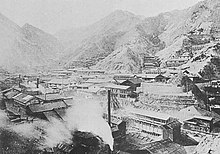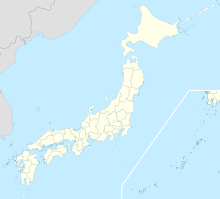Ashio copper mine

Ashio Copper Mine circa 1895
|
|
| Location | |
|---|---|
| Location | |
| Prefecture | |
| Country | Japan |
| Coordinates | 36°38′0″N 139°26′23″E / 36.63333°N 139.43972°ECoordinates: 36°38′0″N 139°26′23″E / 36.63333°N 139.43972°E |
| Production | |
| Products | Copper |
| History | |
| Opened | Before 1600 |
| Closed | 1973 |
The Ashio Copper Mine, Ashio, , Japan, became very significant from the end of the 19th century to the mid-20th century. It was the site of major pollution in the 1880s and the scene of the 1907 miners riots.
The Ashio mine has been in existence at least since 1600 when it belonged to the Tokugawa shogunate. At that time it produced about 1,500 tons annually, although this declined when the mine was closed in 1800. It became privately owned in 1871 following the industrialisation initiated by the Meiji restoration. By 1877 it became the property of Furukawa Ichibei, and by the 1880s production had increased dramatically, reaching 4,090 tons by 1885, 78 per cent of the total output of the Furukawa mines and 39 percent of Japan's copper production.
The Ashio mine was shut down in 1973.
The Ashio Copper Mine Incident is the name given to the environmental disaster that occurred as a result of the Ashio mining operations in the late 19th and early 20th centuries. From 1880 onwards, people living along the Watarase and Tone rivers downstream of the mines noticed the water changing colour and the fish dying. Within a decade, the fish population had been almost completely destroyed and around 3000 fishermen in the area were put out of work. Further, the expansion of the Ashio mines necessitated widespread deforestation to meet the mines' demand for timber. This meant that the towns downstream of the mines lost their flood protection. The first major flood resulting from this was in 1890 and it swept down waste from the slag heaps produced by the mines onto the fields, leaving them largely sterile. In 1896, a larger flood followed, causing still further environmental damage. In 1897, after considerable delays, the Japanese government decided to act and Furukawa Corporation, the company running the mine, began to build filtration systems to reduce the problem of pollution. After resigning from the National Diet, representative Shozo Tanaka delivered an appeal to the Emperor detailing the disaster. However the problem did not immediately go away, and protests continued for some years. In 1911, the government passed the Factory Law which was Japan's first law to address industrial pollution.
...
Wikipedia

